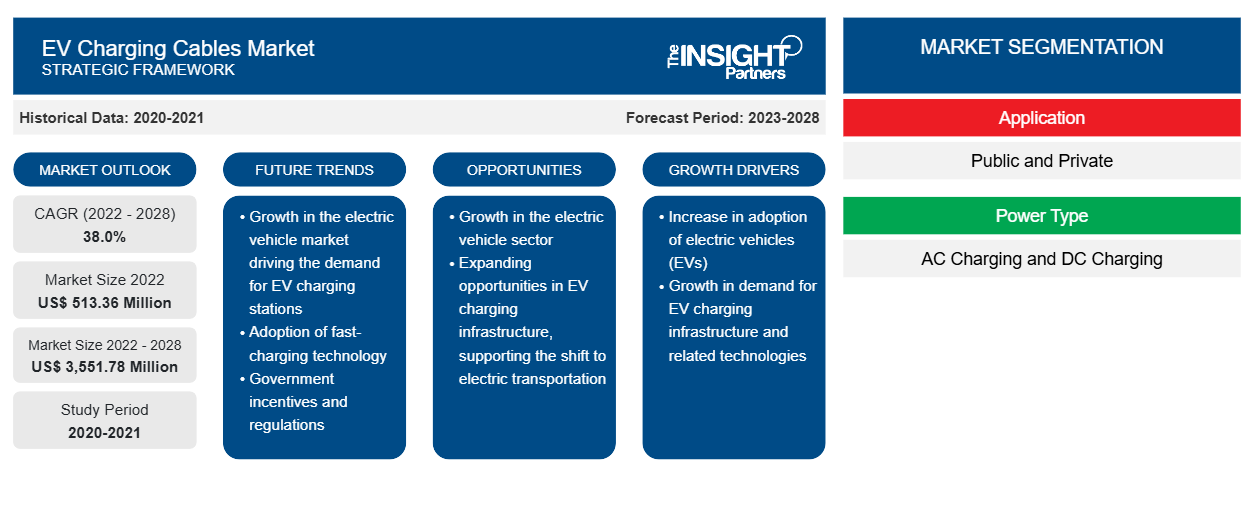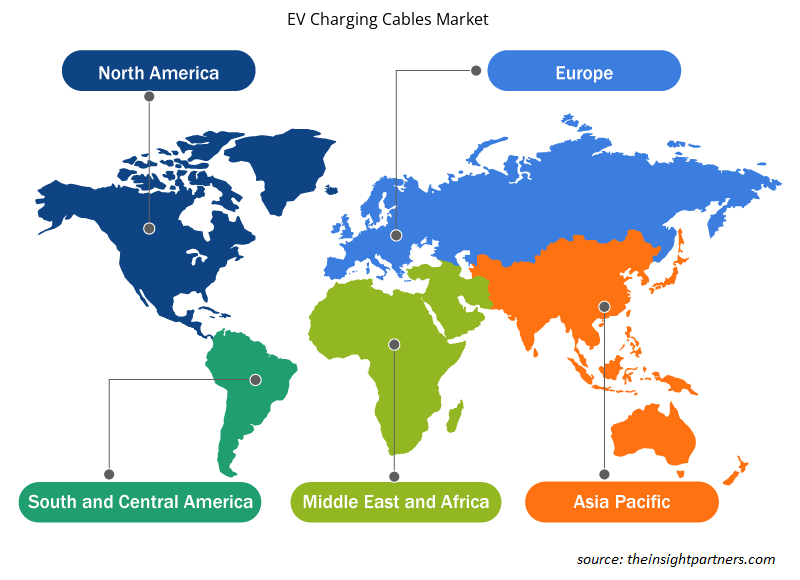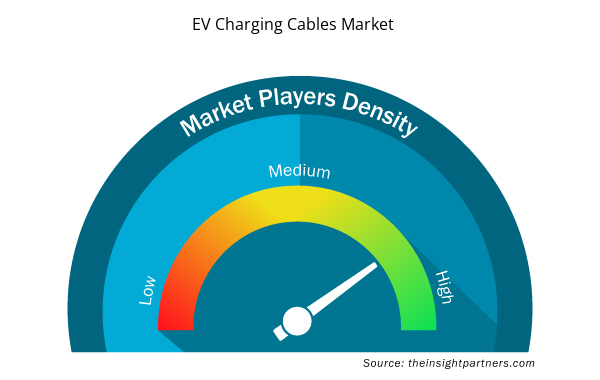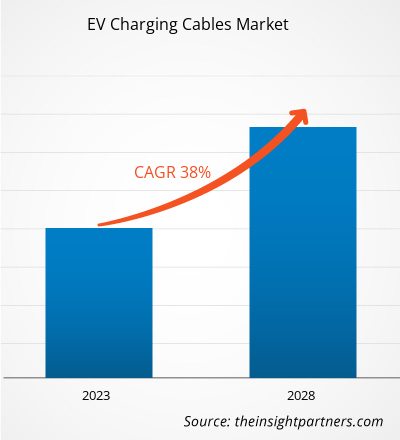[Research Report] The EV charging cables market is expected to grow from US$ 513.36 million in 2022 to US$ 3,551.78 million by 2028. It is estimated to grow at a CAGR of 38.0% from 2022 to 2028.
Incentives introduced by multiple national governments are expected to drive the Europe EV charging cables market growth in the next five years. Europe has been a fastest region in the growth of the electric vehicle market: a compound annual growth rate of 60% from 2016 to 2020, compared with increases of 36% in China and 17% in the US, according to the International Energy Agency (IEA). In the EU's largest market, Germany, several policies have been designed to increase EV charging cables market size. As per the policy, any privately owned EVs registered until the end of 2020 will have a 10-year tax exemption, and EVs with a sales price below US$ 45,300 will qualify for a US$ 10,100 subsidy until December 2021. Spain has reduced tax by 75 % for EVs in big cities, such as Madrid and Barcelona. The country also has established a scheme that subsidizes the purchase of EVs by USD $4,067–5,083, depending on if a vehicle aged seven years or older is scrapped. In Italy, EVs are tax exempt for five years from registration and get a 75% reduction in tax after that. Italy also has a bonus-malus scheme. As per the scheme, vehicles are subsidized up to USD $6,100 per car emitting less than 70g of CO2/km, but penalized by USD $2,541 per car if they emit above 250g of CO2/km. Such initiatives taken by European countries drive the adoption of EVs and eventually fuel the EV charging cables market growth in the region.
Moreover, Europe is taking unprecedented steps to phase out gasoline and diesel cars and bring an end to the almost 150-year-long era of the internal combustion engine. The UK's 2030 ban on these conventional cars and Germany's four-year extension of subsidies for EVs reflect the inducement approach governments are taking to get automakers to embrace electrification. Regulatory pressure already has helped EVs seize a larger share of car sales in Europe than any other developed auto market across the world thereby increasing the EV charging cables market growth. Additionally, to bridge the cost gap between electric vehicles and conventional cars, national or local governments of Europe often provide consumer incentives in the form of one-time subsidies, tax breaks on vehicle purchase and operation, or preferred or free access to certain road infrastructure. Also, in the beginning of 2019, European Union (EU) approved regulations required to include electric car chargers at any new house or apartment building, in a move that has been considered vital to the success of EV uptake. Different patterns of public charging infrastructure are emerging among leading European markets, which would increase the EV charging cables market share in the region during the forecast period.
Customize This Report To Suit Your Requirement
You will get customization on any report - free of charge - including parts of this report, or country-level analysis, Excel Data pack, as well as avail great offers and discounts for start-ups & universities
EV Charging Cables Market: Strategic Insights

- Get Top Key Market Trends of this report.This FREE sample will include data analysis, ranging from market trends to estimates and forecasts.
You will get customization on any report - free of charge - including parts of this report, or country-level analysis, Excel Data pack, as well as avail great offers and discounts for start-ups & universities
EV Charging Cables Market: Strategic Insights

- Get Top Key Market Trends of this report.This FREE sample will include data analysis, ranging from market trends to estimates and forecasts.
Impact of COVID-19 Pandemic on EV Charging Cables Market
In 2020, the impact of COVID-19 pandemic differed from nation to nation across Europe. In the region, the UK, Italy, Russia, France, Germany, and Spain are among the major countries affected by the pandemic. Due to the increasing number of recorded cases, a few of these nations had to impose stringent and longer lockdown along with social isolation in 2020. The lockdown affected electric car sales, but there were early signs of electric vehicle market resilience for two main reasons. First, policy support was strong, in particular in Europe as 2020 was an important target year for emissions standards. Purchase incentives increased, notably in Germany. Second, continued declines in battery costs, as upgraded original equipment manufacturer (OEM) offers model choice and performance, fleet operators initiate their technology transition, and the enthusiasm of electric car buyers (often affluent households less affected by the economic downturn) provides fertile ground for continued EV uptake.
Market Insights – EV Charging Cables Market
The EV charging cables market was dominated by the Rest of the World. Europe is the second-largest contributor to the market, followed by North America.
In North America, the increasing demand from electric vehicle owners to reduce the charging time of electric vehicles and rising interest and development by various public and private market players in the region propel the EV charging cables market size. For instance, in 2020 Xcel Energy planned to invest US$ 110 million to prepare for 20% EV market penetration in Colorado by 2030. In 2020, Uber and Lyft announced intentions to be 100% electric by 2030. California and Massachusetts intend to require 100% EV sales by 2035. Also, the US highway reauthorization, America’s Transportation Infrastructure Act of 2019 earmarks capital for public EV charging infrastructure. Therefore, increasing funding by the government for expanding public charging infrastructure would drive the growth of the EV markets and eventually bolster the EV charging cables market share.
Cable Length-Based Insights
Based on cable length, the EV charging cables market is segmented into 2–5 meters, 6–10 meters, and >10 meters. In 2021, the 2-5 meters segment dominated the EV charging cables market. There is a high demand for 2–5 meters cable in homes and the charging station where the area of the station is small. Also, the same segment is expected to retain its dominance during the forecast period.
Coroplast Group; Sinbon Electronics Co., Ltd.; TE Connectivity; Phoneix Contact; Besen International Group Co., Ltd.; Dyden Corporation; Teison Energy Technology Co., Ltd.; General Cable Technologies Corporation; System Wire Cable; Aptiv; Leoni AG; Brugg eConnect; Ionity Gmbh; Chengdu Khons Technology Co., Ltd. are among the companies profiled in the EV charging cables market study. In addition to these players, multiple prominent global and regional companies, emerging players, market disruptors, and niche market players were analyzed during the market study.
EV Charging Cables Market Regional Insights
The regional trends and factors influencing the EV Charging Cables Market throughout the forecast period have been thoroughly explained by the analysts at Insight Partners. This section also discusses EV Charging Cables Market segments and geography across North America, Europe, Asia Pacific, Middle East and Africa, and South and Central America.

- Get the Regional Specific Data for EV Charging Cables Market
EV Charging Cables Market Report Scope
| Report Attribute | Details |
|---|---|
| Market size in 2022 | US$ 513.36 Million |
| Market Size by 2028 | US$ 3,551.78 Million |
| Global CAGR (2022 - 2028) | 38.0% |
| Historical Data | 2020-2021 |
| Forecast period | 2023-2028 |
| Segments Covered |
By Application
|
| Regions and Countries Covered | North America
|
| Market leaders and key company profiles |
EV Charging Cables Market Players Density: Understanding Its Impact on Business Dynamics
The EV Charging Cables Market is growing rapidly, driven by increasing end-user demand due to factors such as evolving consumer preferences, technological advancements, and greater awareness of the product's benefits. As demand rises, businesses are expanding their offerings, innovating to meet consumer needs, and capitalizing on emerging trends, which further fuels market growth.
Market players density refers to the distribution of firms or companies operating within a particular market or industry. It indicates how many competitors (market players) are present in a given market space relative to its size or total market value.
Major Companies operating in the EV Charging Cables Market are:
- Besen International Group Co., Ltd.
- Coroplast Group
- Dyden Corporation
- General Cable Technologies Corporation
- Phoenix Contact E-Mobility
Disclaimer: The companies listed above are not ranked in any particular order.

- Get the EV Charging Cables Market top key players overview
The EV charging cables market players are majorly adopting the strategy of market initiatives, which involves the expansion of footprint across the world and meeting the surge in customer demand. The market players are mainly focusing on product and service enhancements by integrating advanced features and technologies into their offerings.
- In February 2022, the US Department of Transportation announced its plans to provide US$ 5 billion dollars to the US states over a plan of the next 5 years for the establishment of electric vehicle charging infrastructure along the US interstate highway system.
- Historical Analysis (2 Years), Base Year, Forecast (7 Years) with CAGR
- PEST and SWOT Analysis
- Market Size Value / Volume - Global, Regional, Country
- Industry and Competitive Landscape
- Excel Dataset



Report Coverage
Revenue forecast, Company Analysis, Industry landscape, Growth factors, and Trends

Segment Covered
Application, Power Type, Cable Length, Charging Level, Jacket Material, Shape, Charging Cable Type, and IEC Mode

Regional Scope
North America, Europe, Asia Pacific, Middle East & Africa, South & Central America

Country Scope
Brazil, Canada, China, France, Germany, India, Italy, Japan, Mexico, Russian Federation, South Africa, South Korea, United Kingdom, United States
Frequently Asked Questions
What is the incremental growth of the EV charging cables market during the forecast period?
The incremental growth of the EV charging cables market for the RoW region is USD $1,551.76 million.
Which is the leading application segment in the EV charging cables market?
The private segment led the EV charging cables market in 2021.
Which is the fastest growing regional market?
The rest of the world is the fastest-growing regional market in the global EV charging cables market in 2021.
Which are the key players holding the major market share of the EV charging cables market?
The key players holding the major market share of the EV charging cables market are Leoni AG, TE Connectivity, BESEN, Aptiv, and Coroplast.
What will be the global market size for the EV charging cables market by 2028?
The global EV charging cables market size is projected to reach US$ 3,551.78 million by 2028.
What is the estimated global market size for the EV charging cables Market in 2022?
The global EV charging cables market is expected to be valued at US$ 513.36 million in 2022
What are the future trends in the EV charging cables market?
The Future trends impacting the EV charging cables market are -- Emergence of E-Mobility and Advanced Charging Technologies
What are the driving factors impacting the global EV charging cables market?
The driving factors impacting the EV charging cables market are
I. Surge in EV Vehicle Production
II. Increase in EV Charging Facilities
Trends and growth analysis reports related to Electronics and Semiconductor : READ MORE..
The List of Companies - EV Charging Cable Market
- Besen International Group Co., Ltd.
- Coroplast Group
- Dyden Corporation
- General Cable Technologies Corporation
- Phoenix Contact E-Mobility
- Sinbon Electronics Co., Ltd.
- Systems Wire and Cable
- TE Connectivity
- Teison Energy Technology Co., Ltd.
- Aptiv
- Leoni AG
- BRUGG eConnect
- Ionity GmbH
- Chengdu Khons Technology Co., Ltd

 Get Free Sample For
Get Free Sample For